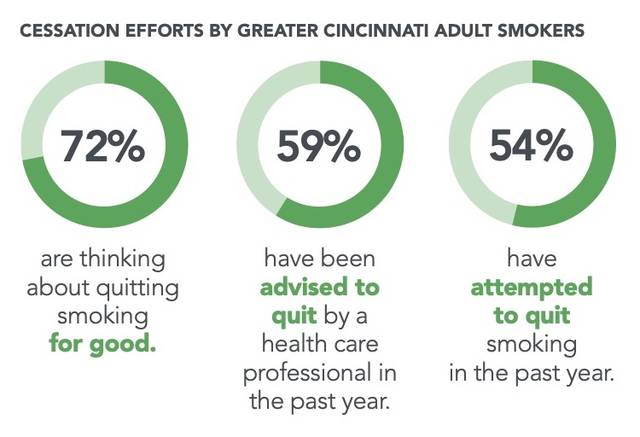
Fifty-four percent of adult smokers in the Greater Cincinnati area attempted to quit smoking in 2019, and 72 percent are thinking about quitting for good, according to Interact for Health’s 2019 Greater Cincinnati Adult Tobacco Survey.
The survey — which included more than 2,000 adults in Southwestern Ohio, Northern Kentucky and Southeastern Indiana — also found that more than 25 percent of adults in the Greater Cincinnati area reported they used to smoke; 19 percent said they currently smoke.
“When those rates are applied based on the population of the region, nearly half a million people currently living in Greater Cincinnati have successfully quit smoking,” Interact for Health said in a press release.
Highland County Health Commissioner Jared Warner told The Times-Gazette 54 percent is a significant number of people in the region attempting to quit smoking, which he attributes to the number of resources available to help tobacco users quit.
“There are a bunch of resources out there. I’d really encourage people to take advantage of some of the work that the state of Ohio has put into this. That’s one of the reasons you see those rates being so high,” Warner said. “We’ve gotten the message across really well that cigarettes and tobacco are bad for you. Now our job is really connecting people to resources, so they can leave tobacco behind and start improving their health.”
Though Interact for Health hasn’t released Highland County-specific data on the issue, Warner predicted that the data is similar in Highland County.
“These numbers are probably going to be consistent in Highland County like they are across the rest of the region,” Warner said. “We tend to focus at the health department on youth use of tobacco, especially in our middle school and high school age groups. That’s where, in Highland County, we tend to do much more poorly than the rest of the nation. We’ve done some local surveys and partnerships with Interact for Health in the past, just looking specifically at youth tobacco use.”
Warner called the survey’s results encouraging, though.
“It’s really good, and it’s encouraging to see those numbers continue to increase,” Warner said. “We were really making some progress in reducing the number of new tobacco users, and then e-cigarettes showed up and really kind of reversed that trend. But it’s great to see adult smokers looking for methods to quit smoking and reduce the amount of tobacco that they’re using.”
Warner said that because of the county’s increased rate of tobacco use, Highland County also has an increased rate of smoking-related cancers.
“We talk a lot about the health impacts and the amount of lung cancer and other cancer cases in Ohio, in particular in Highland County,” Warner said. “We tend to have, in Highland County, higher rates of lung cancer than the rest of Ohio, and Ohio as a state is worse off than the rest of the nation, and that’s all tied into our increased rate of tobacco use.”
Warner said the health department speaks to current tobacco users about more than just the impact tobacco can have on their health.
“We also get into the economic impact of tobacco use, and how much money it costs to support those habits. With our teenage groups, we also talk about the fact that you don’t want to develop an addiction to nicotine right when you’re starting to first get your real taste of freedom,” Warner said. “You’re getting your driver’s license, you’re getting ready to graduate high school — this is not the time you want to attach yourself to an addictive substance and lose some of that freedom that you’re just starting to gain.”
He encouraged parents and guardians to talk to their children about tobacco and vape products.
“We’re still really struggling in Highland County and across Ohio to get the message across that vaping and e-cigarettes are tobacco products, and you need to look at those in the same way you look at cigarettes and tobacco, especially in the teenage years. There are some serious health consequences,” Warner said.
Interact for Health’s 2019 Greater Cincinnati Adult Tobacco Survey also asked those who successfully quit smoking what methods helped them.
“Prescription or over-the-counter cessation medications were most common at 36 percent, followed by no assistance/cold turkey (25 percent),” Interact for Health said.
Warner said when the health department speaks to smokers about the best ways to quit, it’s really whatever works for them.
“Our approach would be whatever method works for you. Find some way to get off of tobacco,” Warner said. “There are a lot of resources out there, especially if you’ve got insurance coverage. There are a lot of resources that insurance will cover to help you get off of tobacco.”
Warner said that Highland County Community Action Organization offers a “Baby and Me Tobacco Free” program, which helps pregnant women quit smoking. For more information, go to hccao.org/health/baby-me-tobacco-free.
Warner also recommends using the Ohio Tobacco Quit Line, which can be accessed by calling 1-800-QUIT-NOW (7848-669) or by going to ohio.quitlogix.org. He said the Ohio Tobacco Quit Line will enable those thinking about quitting to take an assessment to evaluate where they are in the process. The assessment can connect smokers with resources based on their progress.
Reach McKenzie Caldwell at 937-402-2570.


